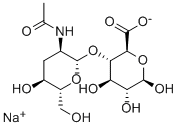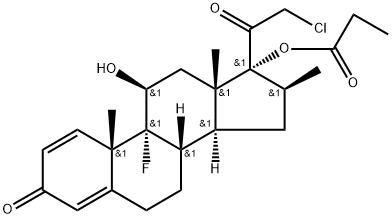3-Chloropropionic acid
- CAS NO.:107-94-8
- Empirical Formula: C3H5ClO2
- Molecular Weight: 108.52
- MDL number: MFCD00002764
- EINECS: 203-534-4
- SAFETY DATA SHEET (SDS)
- Update Date: 2025-09-25 17:15:13

What is 3-Chloropropionic acid?
Chemical properties
white to beige crystalline low melting mass
The Uses of 3-Chloropropionic acid
3-Chloropropionic acid was used to study the degradation of 3-chloropropionic acid by Pseudomonas sp. strain isolated from rice paddy fields. It was also used in determination of 3-bromopropionic acid, biomarker for the exposure to 1-bromopropane in human urine by gas chromatography
The Uses of 3-Chloropropionic acid
3-Chloropropionic acid was used to study the degradation of 3-chloropropionic acid by Pseudomonas sp. strain isolated from rice paddy fields. It was also used in determination of 3-bromopropionic acid, biomarker for the exposure to 1-bromopropane in human urine by gas chromatography.
General Description
A white crystalline solid with a sharp odor. Denser than water.
Air & Water Reactions
Water soluble.
Reactivity Profile
2-CHLOROPROPIONIC ACID reacts exothermically with bases. Reacts with aqueous solutions containing a base and dissolves if neutralization generates a soluble salt. May react with active metals to form gaseous hydrogen and a metal salt. May corrode or dissolve iron, steel, and aluminum parts and containers. Reacts with cyanide salts to generate gaseous hydrogen cyanide. Reacts with diazo compounds, dithiocarbamates, isocyanates, mercaptans, nitrides, and sulfides to generate flammable and/or toxic gases and heat. Reacts with sulfites, nitrites, thiosulfates (to give H2S and SO3), dithionites (SO2), to generate flammable and/or toxic gases and heat. Reacts with carbonates and bicarbonates to generate a harmless gas (carbon dioxide) but some heat. Can be oxidized by strong oxidizing agents and reduced by strong reducing agents. These reactions generate heat. A wide variety of products is possible. May initiate polymerization reactions or catalyze other chemical reactions. Fires produces highly toxic chloride fumes [USCG, 1999].
Health Hazard
Contact may cause skin and eye burns. Harmful if swallowed.
Purification Methods
3-Chloropropionic acid [107-94-8] M 108.5, m 41o, 4.08. Crystallise the acid from pet ether or *benzene. [Beilstein 2 IV 748.]
Properties of 3-Chloropropionic acid
| Melting point: | 37 °C |
| Boiling point: | 203-205 °C(lit.) |
| Density | 1,27 g/cm3 |
| refractive index | 1.4380 (estimate) |
| Flash point: | >230 °F |
| storage temp. | Store below +30°C. |
| solubility | H2O: soluble50mg/mL, clear, colorless |
| form | Crystalline Low Melting Mass |
| pka | 3.98(at 25℃) |
| color | White to beige |
| PH | <1 (200g/l, H2O, 20℃) |
| Water Solubility | freely soluble |
| Merck | 14,2159 |
| BRN | 1098495 |
| CAS DataBase Reference | 107-94-8(CAS DataBase Reference) |
| NIST Chemistry Reference | Propanoic acid, 3-chloro-(107-94-8) |
| EPA Substance Registry System | 3-Chloropropionic acid (107-94-8) |
Safety information for 3-Chloropropionic acid
| Signal word | Danger |
| Pictogram(s) |
 Corrosion Corrosives GHS05  Skull and Crossbones Acute Toxicity GHS06  Exclamation Mark Irritant GHS07  Health Hazard GHS08 |
| GHS Hazard Statements |
H290:Corrosive to Metals H301:Acute toxicity,oral H302:Acute toxicity,oral H314:Skin corrosion/irritation H318:Serious eye damage/eye irritation H341:Germ cell mutagenicity |
| Precautionary Statement Codes |
P201:Obtain special instructions before use. P202:Do not handle until all safety precautions have been read and understood. P234:Keep only in original container. P260:Do not breathe dust/fume/gas/mist/vapours/spray. P264:Wash hands thoroughly after handling. P264:Wash skin thouroughly after handling. P270:Do not eat, drink or smoke when using this product. P280:Wear protective gloves/protective clothing/eye protection/face protection. P310:Immediately call a POISON CENTER or doctor/physician. P390:Absorb spillage to prevent material damage. P303+P361+P353:IF ON SKIN (or hair): Remove/Take off Immediately all contaminated clothing. Rinse SKIN with water/shower. P305+P351+P338:IF IN EYES: Rinse cautiously with water for several minutes. Remove contact lenses, if present and easy to do. Continuerinsing. P308+P313:IF exposed or concerned: Get medical advice/attention. P405:Store locked up. P406:Store in corrosive resistant/… container with a resistant inner liner. P501:Dispose of contents/container to..… |
Computed Descriptors for 3-Chloropropionic acid
| InChIKey | QEYMMOKECZBKAC-UHFFFAOYSA-N |
New Products
4,4-Difluoropiperidine hydrochloride tert-butyl 9-methoxy-3-azaspiro[5.5]undecane-3-carboxylate Indole Methyl Resin N-Isopropylurea N,N-Dicyclohexylcarbodiimide(DCC) MELDRUMS ACID 5-METHYLISOXAZOLE-4-CARBOXYLIC ACID Magnessium Bis glycinate Zinc ascorbate 1-bromo-2-butyne 2-acetamidophenol 9(10H)-anthracenone Erythrosin B, 4-Piperidinopiperidine 2-((4-morpholinophenylamino) (methylthio) methylene) malononitrile 2,4-dihydroxybenzaldehyde 3-(4-morpholinophenylamino)-5-amino-1H-pyrazole-4-carbonitrile Methyl 2-methylquinoline-6-carboxylate 2,6-dichloro-4-nitropyridine 4-Bromo-2-chlorobenzonitrile 2-(benzylamino)acetic acid hydrochloride 4-(tert-Butoxycarbonylamino)but- 2-ynoic acid 3,4-dihydro-2H-benzo[b][1,4]dioxepine 1-Phenyl-1-cycloprppanecarboxylicacidRelated products of tetrahydrofuran








You may like
-
 3-Chloropropionic acid 98%View Details
3-Chloropropionic acid 98%View Details -
 3-Chloropropionic Acid CAS 107-94-8View Details
3-Chloropropionic Acid CAS 107-94-8View Details
107-94-8 -
 3-Chloropropionic acid+ CAS 107-94-8View Details
3-Chloropropionic acid+ CAS 107-94-8View Details
107-94-8 -
 3-(4-amino-1-oxoisoindolin-2-yl)-1-methylpiperidine-2,6-dione 98%View Details
3-(4-amino-1-oxoisoindolin-2-yl)-1-methylpiperidine-2,6-dione 98%View Details -
 20677-73-0 (2,2-diethoxyethyl)methylamine 98%View Details
20677-73-0 (2,2-diethoxyethyl)methylamine 98%View Details
20677-73-0 -
 3-(4-(hydroxyamino)-1-oxoisoindolin-2-yl)piperidine-2,6-dione 98%View Details
3-(4-(hydroxyamino)-1-oxoisoindolin-2-yl)piperidine-2,6-dione 98%View Details -
 57381-49-4 2-bromo-4-chlorobenzonitrile 98%View Details
57381-49-4 2-bromo-4-chlorobenzonitrile 98%View Details
57381-49-4 -
 4,6-dichloropyrimidine-5-carbaldehyde 98%View Details
4,6-dichloropyrimidine-5-carbaldehyde 98%View Details
5305-40-8
